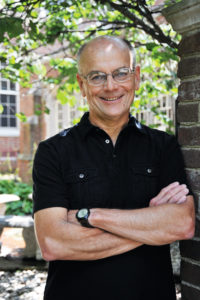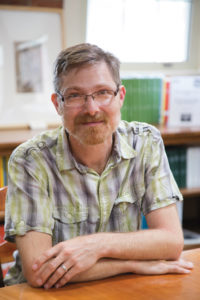
Some changes, such as the construction of a new building, create striking transformations of a place, while others, equally grand, may go largely unnoticed. Curriculum changes generally fall in the latter category even though they can define a college’s identity. Like other liberal arts institutions, Berea has a well defined general studies program, sometimes called a core curriculum, designed to ensure students in all majors receive a well balanced education. It’s often said that general studies is everyone’s major. What complements the core curriculum are the majors, where students gain in-depth knowledge and experience related to a specific field or area. Though the core and the major are complementary opposites, providing breadth and depth, at Berea both are ever developing as part of a tradition of change. In fact, changes to the core have helped fuel changes to traditional majors and the creation of new majors.
Changes to the core are often the most surprising for alumni. Former students for whom “Stories,” a writing class, was an integral and essential part of their first year experience, or those for whom “Religious and Historical Perspectives” (RHP) was a sophomore rite of passage (dreaded by some), may wonder how Berea can still be Berea without those classes. However, college history suggests meeting the needs of new generations is a defining characteristic of the Berea experience. In fact, change has been part of Berea’s core since before the first degree seekers arrived.
In 1855, when Berea first opened its doors to the children of the Berea Ridge, its legal status was a “district school” established for primary and secondary education, but many early supporters were already planning to transform it into a “rudimentary college.” Berea’s founder, John G. Fee, envisioned turning the collection of school houses into an institution that could bestow degrees that would “prepare young men and young ladies to go out as teachers,” according to Elisabeth Peck’s history of the college, Berea’s First 125 Years: 1855-1980.
Despite the humble surroundings, the course of study would have been familiar to students at more established liberal arts colleges of the time. The curriculum was classical in nature, and incoming freshmen were expected to have already taken courses in Latin, Greek, and mathematics. Such preparation put students on a path to develop the skills needed to become leaders in education, law, and ministry. The classical emphasis on public debate ensured early Berea graduates emerged as skilled communicators ready to shape their home communities and surrounding regions. As conditions in the region, nation, and world have changed, so too has the curriculum evolved to meet the new landscape.
The college’s responses to the effects of these changes can be tracked though changes in curriculum, among them the introduction of greater opportunity for interdisciplinary study and the development of interdisciplinary majors that help Berea students meet the demands of humanity’s more complex cultural issues by approaching them from multiple academic perspectives.
Dr. Steve Gowler, who played a major role in developing the current general studies program, sees the core as facilitating change while being part of a continuum. “There has been an interdisciplinary core as part of general education here since the second world war,” he said. In the Winter 2007 edition of the Berea Magazine, Dr. Gowler expressed the hope that the changes made at the time would help students find educational and career paths “out of interests and passions” of their own.
Students’ interests and passions often lead them into fields of study not offered by the college. With the help of faculty, they can develop independent majors leading to a degree. In other cases, where the interests of students and faculty align, an entirely new major or program of study can develop. Programs that have emerged from this process are African and African American Studies, Appalachian Studies (minor), Asian Studies, Peace and Social Justice (minor), Sustainability and Environmental Studies (minor), and Women’s and Gender Studies. Though each of these programs has a different area of concern, they all share an approach that emphasizes understanding a subject using a variety of approaches. For example, the

words Dr. Chris Green, Director of the Appalachian Studies program, uses to explain his field could easily be applied to Asian Studies or Peace and Social Justice:
“Ultimately, education about Appalachia, when at its best, is about practice in context. It’s about a conversation of practices, each seeking to add its part to the great mosaic, each doing so better when it knows the other parts. Since its foundation, Appalachian studies has been about people working together for the sanctity of the region and its people—and that’s a whole lot of pieces.”
By alternating between the part and the whole, the connections between the individual and the culture at large can be brought into sharper relief.
One way interdisciplinary studies calls attention to the connection between part and whole is through an examination of the factors at play in identity politics, both in how individuals assert membership in cultural groups and how individuals are assigned membership in groups by others. In African and African American, Appalachian, and Women’s and Gender studies, understanding how identity politics has often been used against people is one of the crucial points to address when seeking to understand how to reduce the degree to which such categorizations are employed on a cultural level. Culture represents the cross section, the meeting place, of our combined human experience, and as cultures continue to blend and communicate with one another so too will the demand for knowledge that can reach out and connect with various perspectives.
Application, of course, is an essential test for any theory, and Berea students are given many chances to put their interdisciplinary knowledge into practice. Janelle Terry, ’14, notes how she carries skills from the college classroom to her work as a teacher:
“As an EDS (education studies) major, learning how to create interdisciplinary units is a big thing because it shows the interrelated quality of subjects. I think the purpose of education is to prepare students for life in ‘the real world.’ If people’s education is singular, how then are they supposed to be prepared for this multi-faceted world?”
Berea recognizes that the world is in a continuously transitional state. Building upon its humble beginnings as an elementary schoolhouse, Berea continues to adapt its curriculum to meet the demands the world poses for its leaders and citizens alike.

